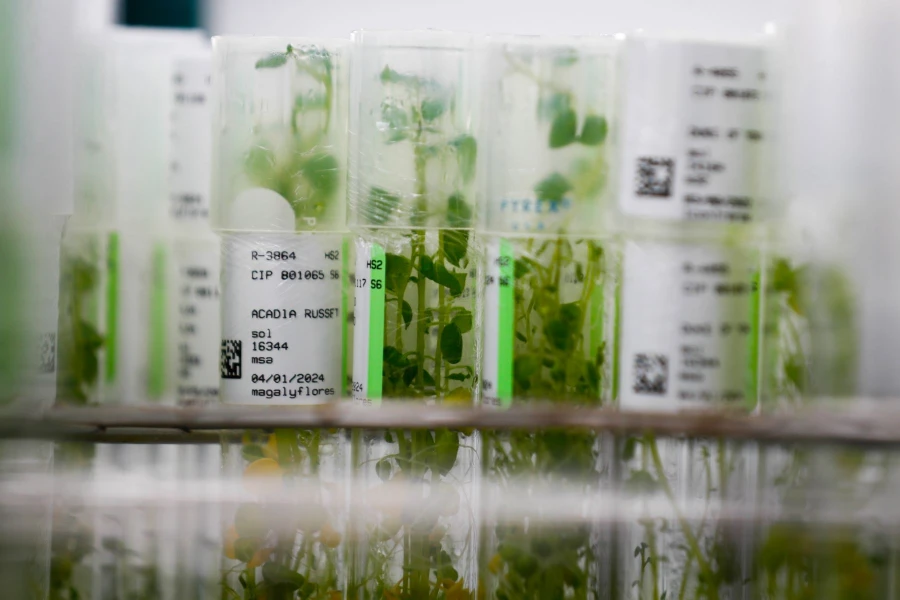Novas variedades de batata desenvolvidas pelo CIP para combater a anemia

Após uma década de pesquisa, os cientistas da Centro Internacional da Batata (CIP) desenvolveram duas novas variedades de batata, Kallpa Yawri e Puka Yawri, com alto teor de ferro e maior capacidade de absorção pelo corpo humano. Essas batatas biofortificadas estão prontas para serem aliadas importantes no combate à anemia no Peru e em todo o mundo.
Em comemoração ao primeiro Dia Internacional da Batata, o CIP apresentou seus esforços na preservação de mais de 5.000 variedades de batata em seu Banco de Germoplasma. Essa instituição tem se dedicado à pesquisa agrícola há mais de 50 anos, concentrando-se no desenvolvimento da cultura emblemática do Peru.
Gabriela Burgos, cientista associada do CIP, explicou à Agencia Andina o processo de desenvolvimento dessas batatas biofortificadas. Foi utilizada a técnica de reprodução convencional, que envolveu o cruzamento natural de batatas com alto teor de ferro com aquelas resistentes a secas, pragas e alta produtividade. Esse processo gerou mais de 10.000 genótipos de batata, que foram avaliados em vários ambientes. Após rigorosos testes e seleção, 30 clones foram escolhidos e cultivados em 11 regiões do Peru.
Não perca essa chance! Assine nosso boletim informativo para receber o conteúdo mais recente diretamente em sua caixa de entrada ou registro GRATUITAMENTE para obter acesso total.
Esses clones passaram por uma seleção participativa, envolvendo os agricultores no processo. As variedades foram então registradas no Serviço Nacional de Saúde Agrária (Senasa) do Peru, atendendo a todos os requisitos regulamentares. Atualmente, o CIP está trabalhando na produção de sementes em escala para garantir que essas batatas fortificadas cheguem às mesas peruanas e além.
A variedade Kallpa Yawri apresenta polpa amarela, enquanto a Puka Yawri tem polpa branca com leve pigmentação. Estudos científicos demonstraram que o ferro presente nas batatas de polpa amarela tem uma taxa de absorção significativamente maior, chegando a 30%, em comparação com outros alimentos ricos em ferro, como lentilhas e feijões. Consequentemente, as batatas de polpa roxa foram excluídas do grupo biofortificado para garantir a absorção ideal do ferro.
Essas variedades biofortificadas podem ser cultivadas em diversas regiões, incluindo Huamachuco, Cajamarca, Huancavelica, Ayacucho, Puno e Cusco. Burgos enfatizou a importância dessas batatas na prevenção da anemia e na manutenção de níveis saudáveis de ferro.
Os testes-piloto mostraram uma adoção bem-sucedida em áreas com alto índice de anemia, com mais de 90% de famílias plantando essas variedades. A CIP está agora multiplicando as sementes para distribuir a aproximadamente quatro milhões de produtores de batata.
Burgos destacou que a modificação genética não foi necessária para esse desenvolvimento. Em vez disso, foi utilizada a biodiversidade do Banco de Germoplasma do CIP, que abriga 5014 variedades de batatas cultivadas e 2638 variedades de batatas silvestres. Essa abordagem garante que as novas batatas sejam desenvolvidas por meio de reprodução convencional, mantendo a integridade genética natural.
O Banco de Germoplasma da CIP emprega várias técnicas de preservação para garantir a disponibilidade de variedades de batata a longo prazo. Essas técnicas incluem a conservação in vitro, a multiplicação de tubérculos e a criopreservação a -196°C, garantindo que as gerações futuras possam ter acesso a esses recursos vitais.
Além desses desenvolvimentos, o CIP está integrando a inteligência artificial para monitorar as variedades de batata. O aplicativo VarScout, que identifica variedades de batata por meio de imagens, e um chatbot alimentado por IA, em colaboração com a Amazon, estão sendo desenvolvidos para agilizar os processos de pesquisa.


Respostas